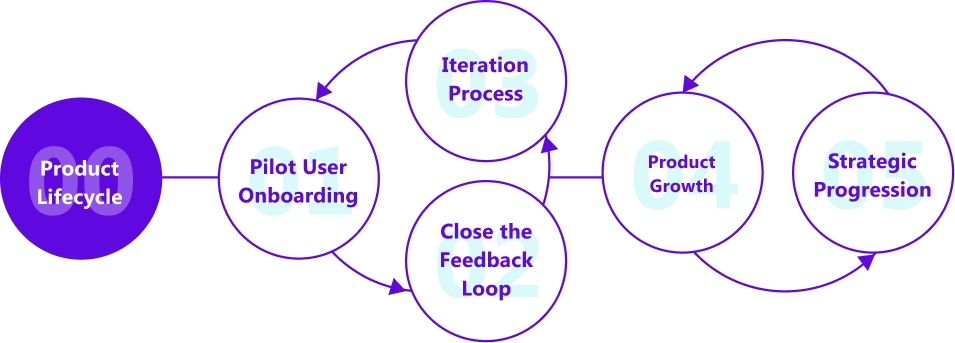¶ Phase Overview

The objective of the Support & Scale phase is to ensure that the product keeps functioning in the market and expands in the right direction dictated by customers’ needs and requirements, to find and retain product-market fit and increase customer value over time.

These are the chapters of this phase. In each chapter, there are relevant skills and readings. You can start reading from the first page of this phase, or select the content from the table of content below.
Start Reading
¶ Support & Scale - Table of Content
¶ Product Lifecycle
As an overarching concept for the Support & Scale phase, the Product Lifecycle presents a great solution that helps us understand and manage the maturity of individual products and the product portfolio we oversee to optimise investments.
To understand the Product Lifecycle, we will discuss the following:
- Product Lifecycle Overview: What is it, and why is it useful?
- Product Lifecycle Stages: What are the stages, and what do they mean?
- Product Lifecycle Management: How can we manage, based on this framework?
¶ Pilot Users Onboarding
After the Production phase, with an MVP in hand, it is time to start going to market and acquiring users. Start small with a limited set of users first to get their feedback, iterate, and expand from there. Big bang launches can lead to widespread frustration if the product is partially on point.
In this chapter, we will cover the key concepts and activities for the early launch of a product:
Infrastructure Planning: Prepare the infrastructure for the right workload
User Acquisition: Get the first pilot customers onto the platform
Data Tracking: Capture the correct data to learn quickly and improve on the right aspects
¶ Close the Feedback Loop
With users on the product and data coming in, we need to ensure that we have the proper methods and rituals to look at that data in ways that helps us make good iteration decisions early on and move toward the coveted product-market fit. This is where we close the feedback loop and fully implement the lean build-measure-learn cycle.
The main activities that are needed to close the feedback loop correctly:
Data Performance Review: Review the data collected as per the predefined measurements and understand the areas that need to improve
Audience Analysis: Match the reality of actual users against the ideal world of personas and get a better understanding of the target audience
Product-Market Fit: Understand whether the product you have created is a strong fit for the JTBD you want to solve and the target audience using it
¶ Iteration Process
While we can keep running many of the rituals from the production process still during Support & Scale, some issues arise once we need to iterate on a live product with users in the market. The Iteration Process helps introduce relevant trade-offs and methods to consider and utilize to complement the product process methods in this phase.
Five aspects will be underlined to help the production team focus at the right pace:
Optimising Team Setup: When working with a live product, we need to split resources between support and production; doing that well is critical to high velocity
Service Level Agreement: Every product makes promises to users about availability, uptime, and error resolution - choosing and supporting those promises well is critical to building trust
Definition of Done: Acceptance criteria must be aligned across the team to facilitate the expected deliverables
Change Control & Management: Stakeholders need to audit and agree on the proposed changes before they get transformed into tasks and assigned to relevant owners
Grayscale Release: To mitigate potentially negative impacts of new releases, this is a method only to impact a small and slowly increasing audience at first to catch problems while not many users have been impacted
¶ Product Growth
Once we have achieved a level of product-market fit, we can invest in growing the customer base as we are assured of a positive CAC / LTV ratio and have started to have a flywheel effect. There are different ways of increasing the customer base, which we will explore, and essential methods of managing the requirements that new impulses that come with that growth.
To drive growth and manage it, we will look at the following:
Product Growth Models: Growing the right way depending on product specifications
User Retention: Ensuring high user retention for growing customer value and LTV
Growth Loops: Building loops of growth and retention that accelerate progress
Requirement Management: Identifying the sources of requirements could help quickly locate and prioritize the most promising features.
Backlog Management: Managing the growing backlog effectively for maximum impact
A/B Testing: Testing different solution options only to implement the best
Communication Rituals: Keeping the information flowing within the company
¶ Strategic Progression
Besides the operational growth of the product, we will also need to regularly evaluate the strategic progression of the whole system of business around it.
In this chapter, we explore key strategy and business concepts relevant to long-term success:
Business Goals: Constantly review the business objectives to confirm the product is on the right track and lead the way as complexity increases
Success Criteria Review: Reviewing key performance indicators in alignment with the overarching success criteria to ensure continued value creation
Product Scaling: Scaling the product proposition to new JTDBs and audiences
Business Model Evolution: Evolving the business model as the product grows and addresses larger audiences and more JTBDs
Lean Product Progress: Applying the lean model to the scale phase with the various options it offers
Product Strategy and Planning: Setting up product strategy and the short-/long-term product planning